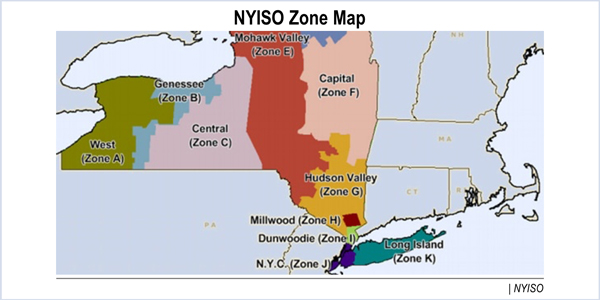By William Opalka
FERC on Friday approved a NYISO plan to protect consumers from rising capacity prices in southeastern New York but rejected a one-year transition to the new rules, saying it “lacks analytical basis” (ER17-446).
NYISO proposed the plan in the fall to address anticipated price spikes in the capacity market in the Lower Hudson Valley and New York City zones, expected after the commission in October allowed the export of electricity from a New York plant in a constrained zone into ISO-NE. (See FERC Sides with ISO-NE in Capacity Dispute with NYISO.)
The ISO’s current capacity market rules fail to recognize the impact of counterflows: They assume that 100% of a generator’s exports from an import-constrained area must be replaced with generation in that locality. NYISO Market Monitor Potomac Economics warned the anomaly means capacity clearing prices in the Lower Hudson Valley “could rise far above competitive levels.”
In response, the ISO proposed a “locality exchange factor,” based on power flow analyses, which found that 47.8% of the capacity exported to ISO-NE from New York’s G-J zones could be expected to be replaced by capacity in the rest of the state. That meant only the remaining 52.2% would need to be replaced by capacity within the zones. NYISO’s proposal was vehemently opposed by generators, who said it would suppress prices. (See NYISO Board Denies Generators’ Appeal on Capacity Cap.)
FERC’s order approved NYISO’s methodology but rejected its proposal for a one-year transition to the new rules (June 2017 through May 2018), during which the ISO planned to use an 80% locality exchange factor rather than the 47.8% figure.
NYISO said the transition was proposed by stakeholders and received votes in support from four out of the five voting sectors. But the commission said there was no “analytical basis” for the 80% factor.
“In its proposal for the locality exchange factor methodology, NYISO states that ‘the price signal should reflect only the portion of the export that must be replaced by resources located within the locality.’ The one-year transition mechanism, however, is not based off of the same power flow analysis that NYISO argues is the best way of accounting for counterflows,” the commission said.
FERC dismissed supporters’ argument that the ISO needed more time to refine and evaluate the methodology. “If NYISO or, in turn, the commission, had some basis to doubt the efficacy of the locality exchange factor methodology, then rather than implementing a transition, the commission would be required to reject the methodology in its entirety as unjust and unreasonable,” it said.
FERC ordered a new plan submitted within 30 days.

Roseton | Google
The methodology was prompted by the commission’s October order allowing Castleton Commodities International’s 1,242-MW Roseton 1 generator, located 43 miles north of New York City, to export 511 MW of its capacity to ISO-NE beginning next June for the 2017/18 delivery year. If Roseton decides to participate in ISO-NE’s 2017/18 commitment period, NYISO would procure unnecessary replacement capacity, as Roseton would still be providing reliability services for the G-J zone, the ISO argued.




